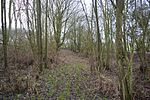Easton, Cambridgeshire
Civil parishes in CambridgeshireEngvarB from June 2016HuntingdonshireVillages in Cambridgeshire

Easton is a village and civil parish in Cambridgeshire, England. Easton lies approximately 6 miles (10 km) west of Huntingdon, between the villages of Ellington and Spaldwick. Easton is situated within Huntingdonshire which is a non-metropolitan district of Cambridgeshire as well as being a historic county of England. Easton is a hamlet which the Anglo Saxons settled in.
Excerpt from the Wikipedia article Easton, Cambridgeshire (License: CC BY-SA 3.0, Authors, Images).Easton, Cambridgeshire
Church Road, Huntingdonshire Easton
Geographical coordinates (GPS) Address Nearby Places Show on map
Geographical coordinates (GPS)
| Latitude | Longitude |
|---|---|
| N 52.3299 ° | E -0.3358 ° |
Address
Church Road
Church Road
PE28 0TU Huntingdonshire, Easton
England, United Kingdom
Open on Google Maps









